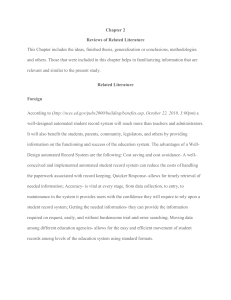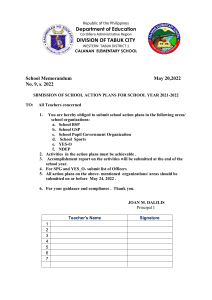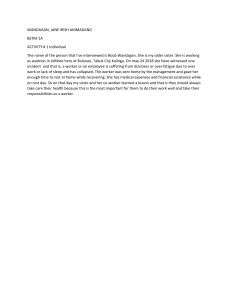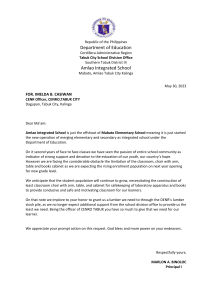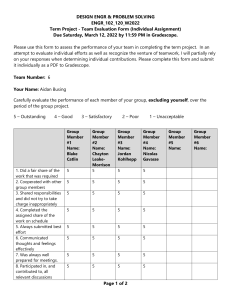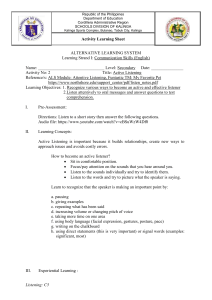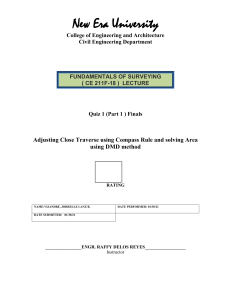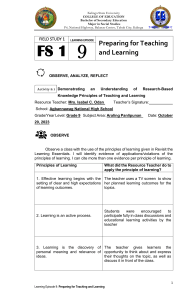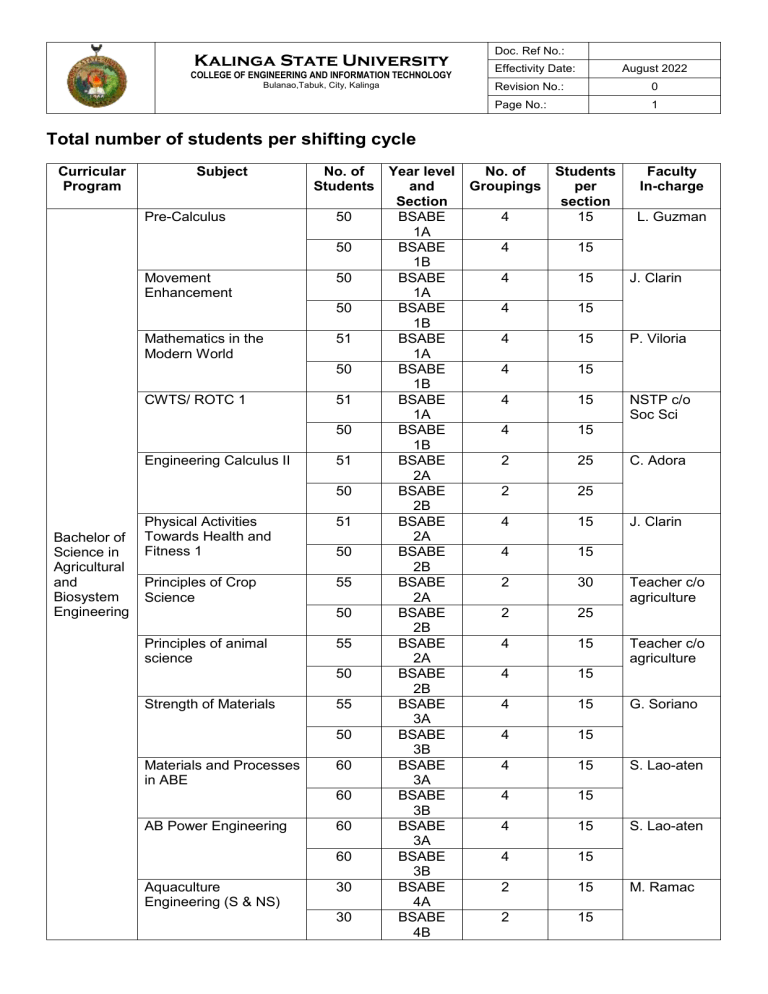
Kalinga State University COLLEGE OF ENGINEERING AND INFORMATION TECHNOLOGY Bulanao,Tabuk, City, Kalinga Doc. Ref No.: Effectivity Date: August 2022 Revision No.: 0 Page No.: 1 Total number of students per shifting cycle Curricular Program Subject Pre-Calculus No. of Students 50 50 Movement Enhancement 50 50 Mathematics in the Modern World 51 50 CWTS/ ROTC 1 51 50 Engineering Calculus II 51 50 Bachelor of Science in Agricultural and Biosystem Engineering Physical Activities Towards Health and Fitness 1 51 Principles of Crop Science 55 50 50 Principles of animal science 55 50 Strength of Materials 55 50 Materials and Processes in ABE 60 60 AB Power Engineering 60 60 Aquaculture Engineering (S & NS) 30 30 Year level and Section BSABE 1A BSABE 1B BSABE 1A BSABE 1B BSABE 1A BSABE 1B BSABE 1A BSABE 1B BSABE 2A BSABE 2B BSABE 2A BSABE 2B BSABE 2A BSABE 2B BSABE 2A BSABE 2B BSABE 3A BSABE 3B BSABE 3A BSABE 3B BSABE 3A BSABE 3B BSABE 4A BSABE 4B No. of Students Groupings per section 4 15 4 15 4 15 4 15 4 15 4 15 4 15 4 15 2 25 2 25 4 15 4 15 2 30 2 25 4 15 4 15 4 15 4 15 4 15 4 15 4 15 4 15 2 15 2 15 Faculty In-charge L. Guzman J. Clarin P. Viloria NSTP c/o Soc Sci C. Adora J. Clarin Teacher c/o agriculture Teacher c/o agriculture G. Soriano S. Lao-aten S. Lao-aten M. Ramac Kalinga State University COLLEGE OF ENGINEERING AND INFORMATION TECHNOLOGY Bulanao,Tabuk, City, Kalinga AB Production, Processing and Storage (NS) 45 AB Plant and Livestock System Engineering (S & NS) 60 1st Year 1A & 1B 2nd Year 2A & 2B 3rd Year 3A & 3B 4th Year 4A & 4B Total: 45 60 BSABE 4A BSABE 4B BSABE 4A BSABE 4B Doc. Ref No.: Effectivity Date: August 2022 Revision No.: 0 Page No.: 1 3 15 3 15 4 15 4 15 M. Ramac G. Soriano 100 101 105 120 426 Prepared by: Checked by: Engr. SOLOMON B. LAO-ATEN BSABE Program Chairperson Engr. RHONJHON R. GARMING, MECE College Dean BRIEF DESCRIPTION OF LABORATORY COURSES / SUBJECTS TO BE CONDUCTED ON A FACETO-FACE SCHEME BACHELOR OF SCIENCE IN CIVIL ENGINEERING TITLE Pre-Calculus Chemistry for Engineers Computer Aided Drafting Engineering Calculus 2 Fundamentals of Surveying BRIEF DESCRIPTION The course introduces the concepts and solve problems involving conic sections, systems of nonlinear equations, series and mathematical induction, circular and trigonometric functions, trigonometric identities, and polar coordinate system This course provides students with core concepts of chemistry that are important in the practice of engineering profession. A fundamental laboratory course designed to relate and apply principles and theories in chemistry to engineering practices. It is a combination of experimental and calculation laboratory. Concepts of computer aided drafting (CAD); Introduction to the CAD environment; terminologies; and the general operating procedures and techniques in entering and executing basic CAD commands. The course introduces the concept of integration and its application to some physical problems such as evaluation of areas, volumes of revolution, force and work. The fundamental formulas and various techniques of integration are taken up and applied to both single variable and multi variable functions. The course also includes tracing of functions of two variables for a better appreciation of the interpretation of the double and triple integral as volume of a three dimensional region bounded by two or more surfaces. This course deals with measurement and distance and distance connections, the use of surveying instruments, area computations, balancing the traverse, elevation determination, and leveling. Stadia surveying, topographic surveying, triangulation and trilateration, missing data, irregular boundaries, and global positioning system. For the fieldwork proper handling and utilization of surveying instrument will be taken. Students will learn how to perform measurement of distance and apply Kalinga State University COLLEGE OF ENGINEERING AND INFORMATION TECHNOLOGY Bulanao,Tabuk, City, Kalinga Engineering Economics Structural Theory 1 Highway and Railroad Engineering Numerical Solutions to CE Problems Geotechnical Engineering 1 (Soil Mechanics) Principles of Transportation Engineering CE Project 1 (Thesis 1) Computer Software’s in Structural Analysis Foundation Engineering Construction Materials and Testing Doc. Ref No.: Effectivity Date: August 2022 Revision No.: 0 Page No.: 1 distance corrections, use and proper handling of surveying instruments and perform calculations related to area computations, latitude and departure computations, DMD and DPD methods of land area determination. Concepts of the time value of money and equivalence; basic economy study methods; decisions under certainty; decisions recognizing risk; and decisions admitting uncertainty. A professional course common to all civil engineering students designed to provide fundamental concepts, principles, and theories in the theory of structures and structural analysis for internal actions in a structure and its deformations under load. Presents the methods and underlying principles for the design and control of the elements of road and railroad infrastructure. Students also become familiar with transportation system terminology, flow analysis, driver, vehicle and road characteristics, and aspects of road geometrics, road construction, drainage, pavements and maintenance. The course provides background on numerical analysis needed to solve civil engineering problems numerically when their analytical solution is either not available or difficult to obtain. Soil formation and identification. Engineering properties of soils. Fundamental aspects of soil characterization and response, including soil mineralogy, soil water movement, effective stress, consolidation, soil strength and soil compaction. Use of soils and geosynthetics in geotechnical and geo environmental applications. Introduction to site investigation techniques. Laboratory testing and evaluation of soil composition and properties. The course gives emphasis on urban transportation planning, design and operation using statistical and modeling techniques and computer methods. It also : At the end of the course, the students must be able to apply concepts and solve problems involving conic sections, systems of nonlinear equations, series and mathematical induction, circular and trigonometric functions, trigonometric identities, and polar coordinate systemcapacity and level of service of air, rail and highway. It also includes safety, environmental impacts and mitigation, transportation policy fundamentals and case studies. Development of a capstone project proposal containing a clear set of objectives, methodology, project implementation plan/schedule and resource requirements. A specialized professional course for civil engineering students in structural engineering aimed at introducing to them the state of the art computer tools in structural analysis that are available in the market. Review of fundamental concepts index and classification properties, water flow, effective stress concept, consolidation behavior, shear strength of soils (undrained and drained condition). Subsurface exploration (main sampling/characterization methods and reporting, variability). Lateral Loads (at rest, active and passive pressures). Earth Retaining structures (walls, braced cuts, dewatering and drainage. Applied load based on codes, and selection of foundation. Shallow foundation design and types, bearing capacity and settlements, testing and evaluation. Deep foundation design, types, bearing capacity and settlements, testing and evaluation. The course deals with the physical properties of common construction materials primarily metals, plastics, wood, concrete, coarse and fine aggregates, asphalt and synthetic materials; examination of material properties with respect to design and use of end product, design and Kalinga State University COLLEGE OF ENGINEERING AND INFORMATION TECHNOLOGY Bulanao,Tabuk, City, Kalinga Doc. Ref No.: Effectivity Date: August 2022 Revision No.: 0 Page No.: 1 control aggregates, concrete and asphalt mixtures, principle of testing, characteristic of test, properties of materials and materials testing equipment. Prepared by: Engr. SOLOMON B. LAO-ATEN BSCE Program Chairperson Checked by: Engr. RHONJHON R. GARMING, MECE College Dean
